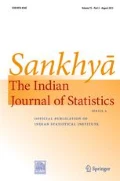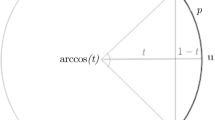Abstract
In this paper, we study cliques and chromatic number in the random subgraph Gn of the complete graph Kn on n vertices, where each edge is independently open with a probability pn. Associating Gn with the probability measure ℙn, we say that the sequence {ℙn} is multiregime if the edge probability sequence {pn} is not convergent. Using a recursive method we obtain uniform bounds on the maximum clique size and chromatic number for such multiregime random graphs.
Similar content being viewed by others
References
Achlioptas, D. and Naor, A. (2005). The two possible values of the chromatic number of a random graph. Annals of Mathematics 162, 1335–1351.
Alon, N. and Spencer, J. (2003). The Probabilistic method. Wiley, New York.
Alon, N. and Krivelevich, M. (1997). The concentration of the chromatic number of random graphs. Combinatorica 17, 3, 303–313.
Bollobás, B. (1988). The chromatic number of random graphs. Combinatorica 8, 49–55.
Bollobás, B. (2001). Random graphs. Cambridge University Press, Cambridge.
Frieze, A. (1990). On the independence number of random graphs. Discrete Mathematics 81, 171–176.
Panagiotou, K. and Steger, A. (2009). A note on the chromatic number of a dense random graph. Discrete Mathematics 309, 3420–3423.
Luczak, T. (1991). The chromatic number of random graphs. Combinatorica 11, 45–54.
Scott, A. (2008). On the concentration of the chromatic number of random graphs. Arxiv Link: 0806.0178.
Shamir, E. and Spencer, J. (1987). Sharp concentration of the chromatic number on random graphs Gn, p.. Combinatorica 7, 121–129.
Acknowledgments
I thank Professors Rahul Roy, Federico Camia, C. R. Subramanian and the referees for crucial comments that led to an improvement of the paper. I also thank Professors Rahul Roy, Federico Camia, C. R. Subramanian and IMSc for my fellowships.
Author information
Authors and Affiliations
Corresponding author
Additional information
Publisher’s Note
Springer Nature remains neutral with regard to jurisdictional claims in published maps and institutional affiliations.
Appendices
Appendix
Appendix: Proof of Theorems 3 and 4
Proof of Theorem 3
We use Theorem 1 with appropriate choices of η and γ.
-
(i) Here α1 = θ1 < 2, α2 = 0 and Wn = log n log(1 pn) = 1 θ1 . For 0 < ξ < 2−θ1 θ1 , we set 𝜖 = ξθ1 2 , η = θ1 2 + ξθ1 and γ = ξθ1 2 so that Eq. 1.3 is satisfied and θclq = ξ. Using 𝜖(2 + 2𝜖)Wn logn ≥ 2𝜖Wn logn = ξ logn in Eq. 1.5, we then get Eq. 1.12.
-
(ii) Here α1 = α2 = 0 and Wn = log n log(1 p). We let 0 < ξ < 1 and set 𝜖 = ξ 2, η = ξ and γ = ξ 2 and so that Eq. 1.3 is satisfied and θclq = ξ. As before, we use 𝜖(2 + 2𝜖)Wn logn ≥ 2𝜖Wn logn = ξ(log n)2 log(1 p) and get Eq. 1.13 from Eq. 1.5.
-
(iii) Here α1 = 0 and α2 = θ2 < 1 and letting 0 < ξ < 1 we set 𝜖 = ξ 4, η = ξ 2 −θ2ξ 2 and γ > 0 smaller than η. With these choices (1.3) is satisfied and moreover θclq = θ2 + 2(η − γ) > θ2. To evaluate Wn, use the log estimates (2.1) and (2.1) to get that \(\frac {\frac {1}{n^{\theta _{2}}}}{1-n^{-\theta _{2}}} > \log \left (\frac {1}{p_{n}}\right ) = -\log \left (1-\frac {1}{n^{\theta _{2}}}\right ) > \frac {1}{n^{\theta _{2}}}\) and so
$$ n^{\theta_{2}}\log{n}\left( 1-\frac{1}{n^{\theta_{2}}}\right) \leq W_{n} = \frac{\log{n}}{\log\left( \frac{1}{p_{n}}\right)} \leq n^{\theta_{2}}\log{n} $$(A.1)for all n large. Moreover
$$ (1-\eta - \alpha_{2})W_{n} = (1-\theta_{2})\left( 1-\frac{\xi}{2}\right)W_{n} \geq (1-\theta_{2})(1-\xi)n^{\theta_{2}} \log{n} $$for all n large and \((2+2\epsilon )W_{n} +1 \leq (2+\xi )n^{\theta _{2}}\log {n}\) and \(\epsilon (2+2\epsilon )W_{n}\log {n} \geq \frac {\xi }{4} n^{\theta _{2}} (\log {n})^{2}\) for all n large. Plugging the above into Eq. 1.5 we get Eq. 1.14.
Proof of Theorem 4
We use Theorem 2 with pn = 1 − rn and appropriate choices of η and γ.
-
(i) Here pn = 1 − rn with α1 = 0 and α2 = θ2 < 1 2. Thus η0 := 1 2(1−θ2) − θ2 < 1 − θ2 and for 0 < ξ < 1 to be determined later, we set
$$ \epsilon = \frac{\xi}{6}, c = (1-\theta_{2})\left( 1-\frac{\xi^{3}}{6}\right) , \eta = \eta_{0} \left( 1+\frac{\xi^{2}}{6}\right) \text{ and } \gamma = \frac{\eta_{0} \xi^{2}}{12}. $$(A.2)We need to ensure that conditions (1.8) and (1.9) hold with α1 = 0 and α2 = θ2. By definition c < 1 − θ2 and η0 < 1 − θ2 and so max(η, c) < 1 − θ2 provided ξ > 0 is small. We choose ξ > 0 smaller if necessary so that
$$ c(\theta_{2} + \eta) = \frac{1}{2} - \frac{\xi^{3}}{12} + \frac{\eta_{0}\xi^{2}}{6}(1-\theta_{2})\left( 1-\frac{\xi^{3}}{6}\right) \geq \frac{1}{2} + \frac{\eta_{0}\xi^{2}}{12}(1-\theta_{2})\left( 1-\frac{\xi^{3}}{6}\right) $$and so θ2 < 1 2 < c(θ2 + η) < 1. To ensure the third condition in Eq. 1.8, we have
$$ 2c(\theta_{2} + \eta-\gamma) = 1-\frac{\xi^{3}}{6} + \frac{\eta_{0}\xi^{2}}{6}(1-\theta_{2})\left( 1 - \frac{\xi^{3}}{6}\right) \!\geq\! 1 + \frac{\eta_{0}\xi^{2}}{12}(1-\theta_{2})\left( 1 - \frac{\xi^{3}}{6}\right) $$provided ξ > 0 is small. Fixing such a ξ we get 2c(θ2 + η − γ) > 1 > 2θ2, since θ2 < 1 2. Thus Eq. 1.8 holds.
To ensure (1.9), we write θchr = 1 1−θ2 + η0ξ2 6 − θ2 (1−θ2)(1−ξ3 6) and choose ξ > 0 small so that (1 −ξ3 6)− 1 ≤ 1 + ξ3 4 and so θchr ≥ 1 + η0ξ2 6 − θ2 (1−θ2) ξ3 4 ≥ 1 + η0ξ2 12 . For future use we choose ξ > 0 smaller if necessary so that
$$ c\theta_{chr} \geq (1-\theta_{2})\left( 1-\frac{\xi^{3}}{6}\right)\left( 1 + \frac{\eta_{0} \xi^{2}}{12}\right) \geq (1-\theta_{2})\left( 1+\frac{\eta_{0}\xi^{2}}{24}\right) > 1-\theta_{2}. $$(A.3)Thus the bounds in Eq. 1.11 is true. We now evaluate the upper and lower bounds in Eq. 1.11. From Eq. A.1 and the fact that 0 < ξ < 1, we get \((2+2\epsilon )W_{n} + 1 \leq \frac {2n^{\theta _{2}}\log {n}}{1-\xi }.\) Similarly
$$ \frac{1+\epsilon}{c(1-\eta - \theta_{2})} = \frac{2\left( 1+\frac{\xi}{6}\right)}{\left( 1-\frac{\xi^{3}}{6}\right)\left( 1-2\theta_{2} - \frac{\eta_{0}\xi^{2}}{3}(1-\theta_{2})\right)} \leq \frac{2(1+\xi)}{1-2\theta_{2}}, $$provided ξ > 0 is small and these estimates obtain the bounds for χ(.) in Eq. 1.15.
To evaluate the exponents in Eq. 1.11, we use Eq. A.1 to get that \(\epsilon (2+\epsilon )W_{n} \log {n} \geq \frac {\xi }{4} n^{\theta _{2}}(\log {n})^{2}\) for all n large. Similarly from Eq. A.3 we get cθchr > 1 − θ2 and this obtains (1.15).
-
(ii) Here pn = 1 − rn = 1 − p and so α1 = α2 = 0. Letting ξ be small such that
$$ \epsilon = \frac{\xi}{6}, \eta = \frac{1}{2} + 2\xi^{2} < 1, \gamma = \xi^{2} \text{ and } c=1-\xi^{3} $$(A.4)we get that the conditions in Eq. 1.8 are true. Also θchr = 1 + 2ξ2 > 1 and so Eq. 1.9 is also true. Thus the bounds in Eq. 1.11 hold. Recalling that Wn = log n log(1 pn) we have that (2 + 2𝜖)Wn + 1 = (2 + ξ 3) log n log(1 1−p) + 1 ≤ 2 (1−ξ) log n log(1 1−p) for all n large. Similarly, the scaling factor in the upper bound in Eq. 1.11 is 1+𝜖c(1−η−α2) = 1+ξ6 (1−ξ3) (1 2 − 2ξ2) ≤ (1 + ξ) if ξ > 0 is small. The exponents in Eq. 1.11 evaluate to cθchr = (1 − ξ3)(1 + 2ξ2) ≥ 1 + ξ2 for all ξ > 0 small and 𝜖(2 + 2𝜖)Wn ≥ 2𝜖Wn = ξ 3 log n log(1 1−p). This obtains (1.16).
-
(iii) Here \(p_{n} = 1-r_{n} = \frac {1}{n^{\theta _{1}}}\) and so α1 = θ1 < 1 and α2 = 0. Let ξ be small such that
$$ \epsilon = \frac{\xi^{2}}{6}, \eta = \frac{1+\theta_{1}}{2} + 2\theta_{1}\xi^{2} < 1, \gamma = \theta_{1}\xi^{2} \text{ and } c=1-\xi^{3}. $$(A.5)Recalling condition (1.8), we have max(η, c) < 1 = 1 − α2,0 < cη = c(α2 + η) < 1 and
$$ \begin{array}{@{}rcl@{}} 2c(\alpha_{2} + \eta-\gamma) &=& 2(1-\xi^{3})(\eta-\gamma) = 2(\eta-\gamma) - 2\xi^{3}(\eta-\gamma)\\ &=& 1+\theta_{1} +2\theta_{1} \xi^{2} - 2\xi^{3}(\eta-\gamma). \end{array} $$(A.6)which is greater than one if ξ > 0 small. Thus Eq. 1.8 is true. Also θchr = 1 + θ1 + 2θ1ξ2 − θ1 1−ξ3 and for all ξ > 0 small, we have 11−ξ3 ≤ 1 + ξ2 and for such ξ, we have θchr ≥ 1 + θ1 + 2θ1ξ2 − θ1(1 + ξ2) = 1 + θ1ξ2 > 1. For future use we set ξ > 0 smaller if necessary so that
$$ c\theta_{chr} \geq (1-\xi^{3}) (1+\theta_{1}\xi^{2}) \geq 1+\frac{\theta_{1}\xi^{2}}{2} > 1. $$(A.7)Thus Eq. 1.9 is also true and consequently, the bounds in Eq. 1.11 hold.
Recalling that Wn = log n log(1 pn) = 1 θ1 we have from Eq. A.5 that (2 + 2𝜖)Wn + 1 = (2 + ξ2 3) 1 θ1 + 1 ≤ 2+θ1 θ1(1−ξ) for all n large, provided ξ > 0 small. Fixing such a ξ, the scaling factor in the upper bound in Eq. 1.11 is
provided we set ξ > 0 smaller if necessary.
Finally, regarding the exponents in Eq. 1.17, we have from Eq. A.7 that cθchr > 1 and moreover 𝜖(2 + 2𝜖)Wn ≥ 2𝜖Wn = ξ2 3 1 θ1 . This obtains (1.17).
Rights and permissions
About this article
Cite this article
Ganesan, G. Cliques and Chromatic Number in Multiregime Random Graphs. Sankhya A 84, 509–533 (2022). https://doi.org/10.1007/s13171-020-00205-4
Received:
Published:
Issue Date:
DOI: https://doi.org/10.1007/s13171-020-00205-4



